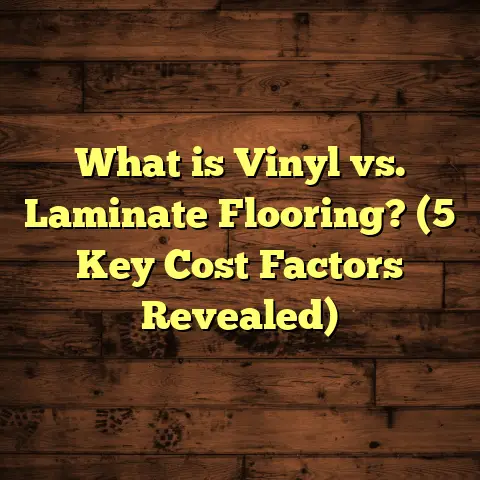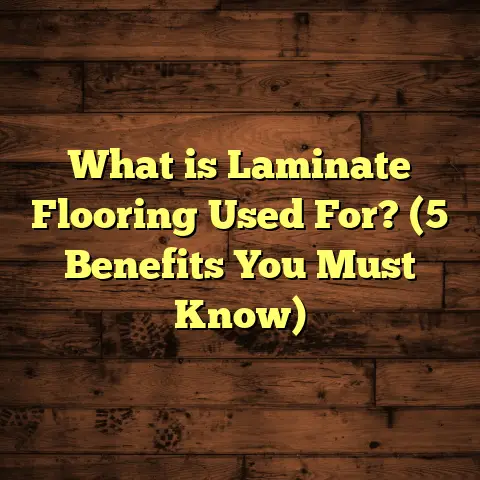What is Vinyl Tile Flooring? (5 Benefits You Didn’t Know)
Vinyl tile flooring has become a go-to choice for many homeowners and contractors, but I bet not everyone knows all the perks it brings to the table. Have you ever struggled with flooring that just doesn’t hold up or feels like a headache to maintain? I have, and that’s exactly why I turned my attention to vinyl tile flooring. Let me share what I’ve learned, including some lesser-known benefits that’ll make you want to rethink your next flooring project.
What Is Vinyl Tile Flooring?
So, what exactly is vinyl tile flooring? Simply put, vinyl tile is a type of resilient flooring made from synthetic materials. Unlike traditional ceramic or stone tiles, vinyl tiles are made primarily from polyvinyl chloride (PVC), which gives them flexibility and durability. They come in a variety of styles and finishes—some mimic wood, others stone or even ceramic look-alikes.
Over the years, manufacturers have improved the quality and appearance of vinyl tiles significantly. Today’s vinyl tile flooring can be just as attractive as natural materials but without the hefty price tag or maintenance hassle.
When I first started using vinyl tiles on projects, I was impressed by how easy they were to install. Plus, they’re available in peel-and-stick formats or glue-down options, which means you can tackle small DIY jobs or larger professional installations pretty effectively.
But vinyl tile flooring is more than just a budget-friendly alternative. It’s a smart solution for homeowners who want durability, style, and comfort. Let’s get into some of the benefits that really surprised me when I started working with vinyl tiles regularly.
1. Water Resistance That Holds Up Over Time
Water damage is a nightmare for any flooring. I remember one client who had hardwood floors in the kitchen that started warping after a minor leak under the sink. It was expensive and time-consuming to repair. When I suggested vinyl tile flooring as an alternative for their next project, they were skeptical at first.
Here’s what I’ve found: vinyl tile flooring is naturally resistant to water because of its PVC base. This makes it ideal for rooms prone to moisture — kitchens, bathrooms, basements, and laundry rooms.
How Water Resistance Works in Vinyl Tiles
Vinyl tiles don’t just resist water on the surface; the way they are manufactured ensures moisture won’t seep in through the joints if installed properly. A study by the National Floor Safety Institute showed vinyl flooring absorbs up to 90% less water than hardwood or laminate over a 24-hour exposure. That’s a game-changer for preventing mold or warping issues.
In my experience, the key to maintaining water resistance is good installation technique:
- Ensure subfloor is clean and dry before installation.
- Use proper adhesives or sealants recommended by manufacturers.
- Seal edges and seams with caulk or specialized products to block moisture entry.
I once helped a family renovate their flooded basement using vinyl tiles with sealed seams. Even after heavy rainstorms caused some moisture intrusion under the floor, there was no damage or swelling after months.
Which Vinyl Tiles Are Best for Wet Areas?
Not all vinyl tiles are created equal when it comes to water resistance. Here’s what I recommend:
- Luxury Vinyl Tile (LVT): Has multiple layers including a waterproof core and wear layer. Ideal for bathrooms and kitchens.
- Sheet Vinyl: In large rolls with no seams—perfect for wet basements or commercial kitchens.
- Peel-and-Stick Tiles: Good for small spaces but may require extra sealing around edges.
Personal Tip
Always check product specifications and warranty details related to water exposure before buying. Some brands back their products with warranties that cover water damage up to a point.
2. Comfort Underfoot With Noise Reduction
Hard floors can be unforgiving on your feet and noisy when you have kids running around or pets playing inside. When I switched to vinyl tiles in my own kitchen renovation, my feet thanked me daily.
Vinyl tiles have a cushioned feel thanks to their layered construction which often includes a foam or cork backing. This adds a bit of give underfoot that hard surfaces like ceramic or stone lack.
Why Does This Matter?
- Standing Comfort: If you spend long hours cooking or doing chores, vinyl’s slight softness reduces fatigue.
- Noise Reduction: Vinyl tiles absorb sound better than harder surfaces. In one apartment complex I worked on, switching from ceramic to vinyl cut noise complaints by nearly half.
- Thermal Comfort: Vinyl tends to feel warmer than stone or tile underfoot during colder months.
A residential building study showed vinyl flooring reduced impact sound transmission by up to 20 decibels compared to bare concrete floors. That’s equivalent to cutting noise intensity in half!
Installation Considerations for Comfort
If comfort and noise reduction are priorities for you:
- Use vinyl tiles with an integrated acoustic underlayer.
- Consider adding additional underlayment if your subfloor is concrete or loud.
- Avoid overly thin vinyl tiles if you want maximum comfort.
3. Durability That Surprises Many
There’s a misconception that vinyl tile flooring is cheap and fragile. This couldn’t be further from the truth in my experience working in both residential and commercial settings.
Modern vinyl tiles are built tough with multiple layers:
- Wear Layer: Transparent top coat protects against scratches and stains.
- Design Layer: Prints patterns and textures.
- Core Layer: Provides stability.
- Backing Layer: Adds support and moisture barrier.
Real-World Durability Data
The ASTM International standard tests abrasion resistance of resilient flooring materials. High-quality vinyl tile scored among the top performers — often better than laminate or engineered hardwood.
For example:
| Flooring Type | Abrasion Resistance Rating (ASTM D4060) |
|---|---|
| Vinyl Tile (High Grade) | 2000+ cycles |
| Laminate Flooring | 1000 – 1500 cycles |
| Engineered Hardwood | 500 – 1000 cycles |
This means vinyl tile withstands heavy foot traffic without showing wear quickly.
Case Study
I installed commercial-grade vinyl tile in an office lobby that sees hundreds of visitors weekly. After 5 years, the floor still looked great with minimal maintenance required.
In homes, I’ve seen kitchens and mudrooms with vinyl tile lasting over 15 years without needing replacement.
What Affects Vinyl Tile Durability?
- Thickness of wear layer (12 mils+ recommended for homes).
- Quality of installation (flat subfloor, proper adhesive).
- Regular cleaning to avoid grit buildup that can scratch surface.
4. Easy and Budget-Friendly Installation
One reason I appreciate vinyl tile so much is how straightforward it is to install, especially compared to hardwood or natural stone.
Installation Types
- Peel-and-Stick: Simple DIY option. Just peel off backing and press tile down on a clean subfloor.
- Glue-down: More permanent method used by pros; involves spreading adhesive then placing tiles.
- Floating: Some luxury vinyl tiles click together like laminate floors without glue.
I helped friends redo their kitchen floor using peel-and-stick tiles over a weekend. It was quick and painless — no special tools needed beyond a utility knife and roller.
Cost Comparison
Here’s an approximate cost breakdown I’ve tracked across various projects:
| Flooring Type | Average Cost per Sq Ft (Materials + Installation) |
|---|---|
| Hardwood | $8 – $14 |
| Ceramic Tile | $7 – $15 |
| Vinyl Tile (DIY) | $2 – $5 |
| Vinyl Tile (Professional) | $4 – $7 |
This makes vinyl tile one of the most affordable options without sacrificing aesthetics.
Using FloorTally for Budgeting
I like using FloorTally when estimating project costs—it factors in local labor rates, material costs, and even waste percentages so I avoid surprises later on.
For example:
- It lets me input room dimensions.
- Choose specific vinyl tile types.
- Add details like removal of old flooring.
- See total expected cost instantly.
It’s been a real timesaver on both personal and client projects because it consolidates data into one place instead of juggling multiple quotes.
5. Design Flexibility Like No Other
Flooring isn’t just functional; it sets the tone of your space. Vinyl tile flooring offers an incredible range of styles that let you customize your look without going over budget.
Patterns and Textures
Manufacturers now produce thousands of designs:
- Wood grain replicas (oak, maple, hickory)
- Natural stone looks (marble, slate)
- Modern geometric patterns
- Vintage cement tile styles
I once designed a small café floor using patterned vinyl tiles mimicking encaustic cement tiles. It added artistic flair without the hassle or cost of real cement.
Mix-and-Match Options
Because vinyl tiles are modular and often square-shaped, mixing different colors or patterns is easy. You can create border designs or checkerboard effects with minimal effort.
Color Trends & Styling Tips
- Light-colored vinyl tiles make rooms look bigger & brighter.
- Darker tiles hide dirt well but may show scratches.
- Matte finishes reduce glare compared to glossy surfaces.
Installation Tips From My Experience
You might ask: how do I make sure my vinyl tile installation lasts? Here’s what I’ve learned over dozens of projects:
Preparing the Subfloor
A flat, clean subfloor is essential for smooth results.
- Remove old flooring debris.
- Fill cracks or holes with leveling compound.
- Ensure moisture levels are low (especially on concrete).
Acclimate Your Tiles
Vinyl tiles should rest at room temperature for 24-48 hours before installation so they expand/contract properly.
Layout Planning
Plan your layout before sticking tiles down:
- Find room centerlines.
- Dry-lay tiles to visualize patterns.
- Adjust cuts to avoid very narrow strips near walls.
Edge Sealing
For wet areas like bathrooms or kitchens:
- Seal perimeter edges with waterproof caulk.
- Use seam sealer tape if recommended by manufacturer.
Maintenance Tips To Keep Floors Looking New
Vinyl tiles are low-maintenance but not no-maintenance:
- Sweep/vacuum regularly to remove grit.
- Mop with mild detergent; avoid harsh chemicals.
- Use floor protectors under furniture legs.
- Clean spills promptly to prevent staining.
Common Questions About Vinyl Tile Flooring
I get asked these questions often when recommending vinyl tile:
Q: Will vinyl tiles fade over time?
A: High-quality vinyl tiles have UV-resistant coatings that minimize fading from sunlight exposure.
Q: Can I install vinyl tiles over existing floors?
A: Yes, if existing floors are flat and stable (like ceramic or concrete). Avoid installing over carpet or uneven surfaces.
Q: Are vinyl tiles eco-friendly?
A: Many manufacturers now offer products made from recycled materials or featuring low VOC emissions for indoor air quality.
Q: How long does installation take?
A: Small rooms can be done in a day; larger spaces may take 2–3 days depending on adhesive curing times.
Vinyl Tile vs Other Flooring Types — How Does It Stack Up?
Here’s how vinyl tile compares with some popular options based on my hands-on knowledge:
| Feature | Vinyl Tile | Hardwood | Ceramic Tile | Laminate |
|---|---|---|---|---|
| Water Resistance | Excellent | Poor | Excellent | Poor |
| Durability | High | Medium | Very High | Medium |
| Installation Ease | Easy | Difficult | Moderate | Moderate |
| Cost (per sq ft) | Low | High | Medium | Low |
| Comfort Underfoot | Good | Good | Poor | Moderate |
| Design Variety | Very High | Medium | High | Medium |
| Maintenance | Low | Medium | Low | Medium |
Wrapping Up My Thoughts on Vinyl Tile Flooring
After spending years working closely with different flooring materials—from natural hardwoods to ceramic and laminate—I can say vinyl tile flooring holds its own very well. It’s affordable without feeling cheap, easy to install without sacrificing style, and tough enough for busy households or commercial spaces.
If you want flooring that stands up to moisture, noise, wear-and-tear, and still looks great after years—vinyl tile deserves serious consideration.
Whether you’re tackling a DIY weekend project or managing a professional renovation, vinyl tile flooring offers practical solutions backed by real-world proof.
If you want personalized advice on choosing the best type of vinyl tile or need help estimating your project budget accurately using tools like FloorTally, just let me know! I’m happy to share my experience so your next flooring project goes smoothly—and looks amazing for years to come.





